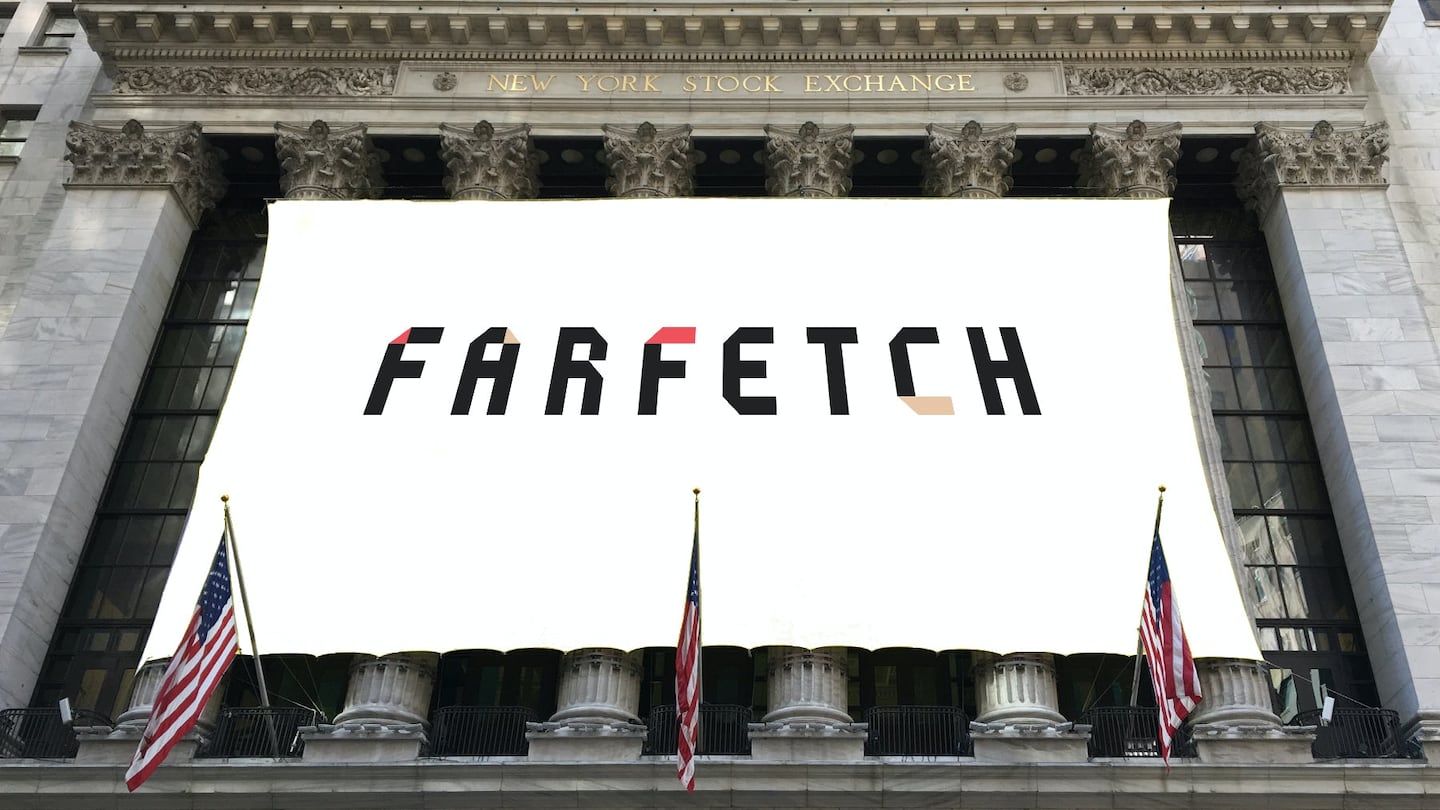NEW YORK, United States — Farfetch has won over millions of consumers from Miami to Dubai to Shanghai. Now, the luxury online marketplace is getting an equally enthusiastic reception on the New York Stock Exchange, where its shares debuted on Friday morning, shooting up more than 42 percent to $28.45 in early trading.
Here's what you need to know about one of the biggest fashion IPOs in years.
RISING DEMAND
Farfetch priced its shares at $20 each. That's above the anticipated range of $17 to $19, which itself was raised $2 from an earlier range of $15 to $17, suggesting the demand for Farfetch shares has been strong. The company and its investors raised $885 million, valuing the business at $5.8 billion, close to the roughly $6 billion valuation of Yoox Net-a-Porter, the world’s biggest online luxury retailer by sales, when
Richemont acquired it earlier this year.
THE IPO LANDSCAPE
Farfetch is going public at a time when the appetite for IPOs is sky-high. Thus far in 2018, 38 technology companies have raised $15.1 billion in US markets, the highest since 2014, according to Dealogic. Newly public shares have outperformed the broader market, rising an average 48 percent post-IPO this year, compared with a 19 percent increase in the S&P 500 technology sector.
However, fashion and retail startups have been slow to tap public markets. Los Angeles-based online retailer Revolve is planning to sell shares to the public later this year, The Wall Street Journal reported in June. Clothing rental site Rent the Runway and resale marketplace TheRealReal are among the companies long rumoured to be on the IPO track.
The last major fashion venture to go public was Stitch Fix last November, another then-unprofitable startup promising to leverage sophisticated use of customer data into growth. Shares dropped below their pricing range to $15 on their debut, leading chief executive
Katrina Lake to tell Recode she regretted that pre-IPO expectations were set so high. The stock has since climbed, ending at $41.66 on Thursday.
THE MARKET OPPORTUNITY AND BUSINESS MODEL
Farfetch is one of the biggest players in online luxury retail, a market that has swelled in recent years thanks to the strong US economy and booming sales to customers in China and other emerging markets. E-commerce sales of luxury goods shot up 24 percent to $27 billion last year, according to Bain & Company. Hot brands like
Gucci, Balenciaga and
Moncler have hundreds of items listed for sale on the site, though others, including Dior and Louis Vuitton, limit online sales to categories like eyewear and vintage.
Unlike department stores like Saks or Barneys New York — or online rivals like Net-a-Porter and MatchesFashion — Farfetch does not take on the risk of buying and holding inventory, instead allowing brands and retailers to sell directly through its marketplace. The company takes an average commission of 30 percent on each sale, on the high end for e-commerce businesses, and helps some sellers with shipping. For sellers, it’s often worth taking on the risk and expense of managing their own inventories to gain access to Farfetch’s growing global customer base. Last year, Farfetch revenue shot up 60 percent to $386 million on a gross merchandise value of about $910 million.
COMPETITION
Farfetch has plenty of competition for well-heeled online shoppers. Net-a-Porter, MatchesFashion and Neiman Marcus-owned MyTheresa are also investing in technology and racing to lock in exclusive relationships with designers and brands. LVMH, the world’s largest luxury group whose premier brands are largely absent from online retailers, has its own e-commerce venture, 24 Sèvres. Farfetch has an edge when it comes to traffic, ranking 34 in SimilarWeb’s rankings of clothing websites, ahead of Net-a-Porter at 118. At $620 per order, the marketplace’s customers also spend far more per basket than YNAP’s, whose average basket size is $385 (a figure that includes lower-priced offering from off-season retailer Yoox). But some investors question whether Farfetch can continue to convince sellers to hand over nearly a third of their revenue in commissions when there appear to be plenty of viable alternatives.
THE INVESTMENT PROPOSITION
Analysts say Farfetch is selling itself to investors as a technology company, with the promise of turning its mastery of customer data and a sophisticated online platform into profits, without the stores, warehouses and other physical assets that weigh down retail margins. Farfetch has promoted this idea with its “Store of the Future” concept, which it describes as an operating system for physical retail technology. A test with
Chanel is in the works.
But for now, those profits remain theoretical; Farfetch’s losses widened by 37 percent to $112 million last year, in part because the company is ramping up spending on its technology.
The mix of retail and technology has attracted some high-profile backers, including Chinese e-commerce giant JD.com, which owns a 14 percent stake in Farfetch and plans to invest in a private placement ahead of the IPO. Artémis, the Pinault family holding company which controls French luxury conglomerate Kering, has indicated it will invest $50 million as well, according to a regulatory filing.
But Farfetch, which has raised over $700 million mainly from European and Asian investors, has not struck much of a chord in Silicon Valley. It remains to be seen which investors will hold onto their stakes post-IPO, though employees will need to hold on to their shares for at least six months before they can sell.
Editor's Note: This article was updated at 4:40pm GMT on 21 September, 2018, to reflect early trading in Farfetch shares on the New York Stock Exchange.
Related Articles:
[ 10 Revelations Buried in Farfetch’s IPO FilingOpens in new window ]
[ Farfetch Files for IPO, Testing Investors' Appetite for LuxuryOpens in new window ]


